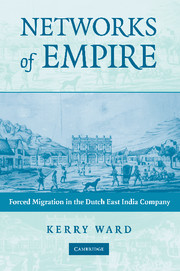Book contents
- Frontmatter
- Contents
- List of Maps
- Acknowledgments
- 1 Networks of Empire and Imperial Sovereignty
- 2 The Evolution of Governance and Forced Migration
- 3 Crime and Punishment in Batavia, circa 1730 to 1750
- 4 The Cape Cauldron: Strategic Site in Transoceanic Imperial Networks
- 5 Company and Court Politics in Java: Islam and Exile at the Cape
- 6 Forced Migration and Cape Colonial Society
- 7 Disintegrating Imperial Networks
- Bibliography
- Index
- VOC Shipping Networks
- References
7 - Disintegrating Imperial Networks
Published online by Cambridge University Press: 30 July 2009
- Frontmatter
- Contents
- List of Maps
- Acknowledgments
- 1 Networks of Empire and Imperial Sovereignty
- 2 The Evolution of Governance and Forced Migration
- 3 Crime and Punishment in Batavia, circa 1730 to 1750
- 4 The Cape Cauldron: Strategic Site in Transoceanic Imperial Networks
- 5 Company and Court Politics in Java: Islam and Exile at the Cape
- 6 Forced Migration and Cape Colonial Society
- 7 Disintegrating Imperial Networks
- Bibliography
- Index
- VOC Shipping Networks
- References
Summary
The Dutch East India Company consisted of networks of trade, shipping, information, law, diplomacy, and migration that combined in different ways in each of its nodes to constitute the whole of its imperial web. The Company's empire emanated from a particular conjuncture in state-building in early modern Europe and derived, and to some extent replicated, the split sovereignty of the United Provinces in its governance structure. The specific terms of the VOC charter set forth by the States-General and overseen by the Seventeen Gentlemen in Europe determined the extent of the Company's domain in the Indian Ocean and granted it partial sovereign rights. In this domain, sovereignty was extended through an evolving legal network created with respect to particular conditions at Batavia. Conditions in Batavia, while not identical to conditions in other imperial nodes, therefore disproportionately determined the parameters of a legal template intended to extend as an imperial network across the whole of the Company's web.
In practice Company law, as developed in Batavia, could not be strictly applied in all its factories, settlements, and colonies. Regional circumstances determined the ability of the Company to impose its jurisdiction in any one node and, correspondingly, local laws were passed to accommodate specific conditions regarding particular, but not all, aspects of the Company's legal code.
- Type
- Chapter
- Information
- Networks of EmpireForced Migration in the Dutch East India Company, pp. 283 - 308Publisher: Cambridge University PressPrint publication year: 2008

